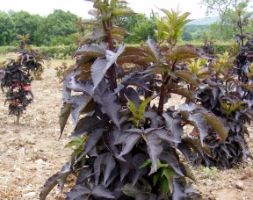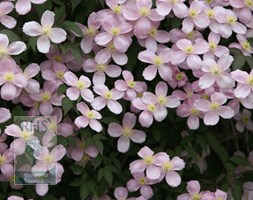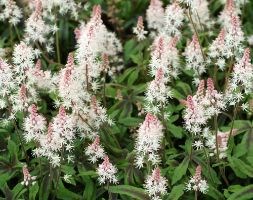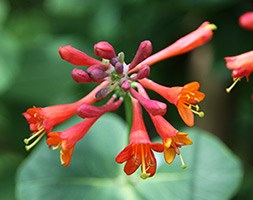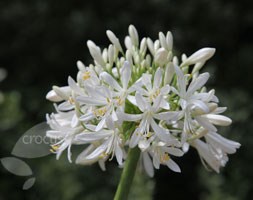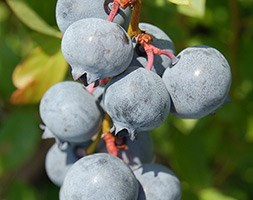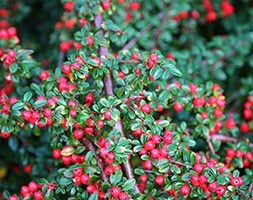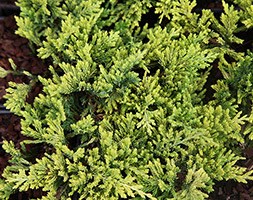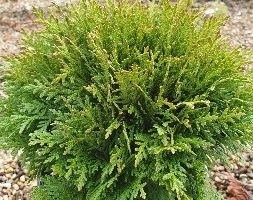New products at Crocus
by Sarah - July 27th, 2014.Filed under: Crocus, New Products.
New products at Crocus
Sambucus nigra f. porphyrophylla Black Tower (‘Eiffel 1’) (PBR) (black tower elder) £12.99
Position: full sun or partial shade Soil: moderately fertile, humus-rich, moist, well-drained soil Rate of Growth: average Flowering period: June fruits are attractive to birds Hardiness: fully hardy This tall and slebnder deciduous shrub is primarily grown for its foliage, which emerges green in spring, but (if exposed to lots of sun) will soon turn a deep burgundy colour. In early summer, the stems are crowned with big, flattened sprays of lightly perfumed, small pink flowers. It makes a dramatic stand-alone statement, and is useful for adding contrast and interest to the shrub border. Garden care: To achieve the best foliage effect cut back to ground level each year in early spring and apply a generous 5-7cm mulch of well-rotted garden compost or manure around the base of the plant.
Clematis montana var. montana (clematis (group 1)) £9.99
Position: full sun or partial shade Soil: fertile, well-drained, neutral soil Rate of growth: fast-growing Flowering period: May to June Flower colour: white Hardiness: fully hardy Vigorous and early flowering, this deciduous climber produces large numbers of single white flowers in late spring and early summer. It is ideal for training through trees or for scrambling up a tall wall in a sunny or partially shaded position. Garden care: No routine pruning is necessary. If the spread of the needs to be restricted prune immediately after flowering, cutting back overlong shoots to healthy buds. Apply a slow-release balanced fertiliser and a mulch of well-rotted garden compost around the base of the plant in early spring.
Tiarella ‘Spring Symphony’ (PBR) (foam flower) £8.99
Position: partial or deep shade Soil: cool, moist, humus-rich soil Rate of growth: fast-growing Flowering period: May to July Flower colour: creamy-white Hardiness: fully hardy Attractive, deeply lobed leaves with a small dark blotch in the centre make a great carpet of foliage throughout the summer. In late spring, slender stems rise up and hold spikes of tiny star-shaped, blush white flowers. This is a brilliant plant for covering the ground in a shady spot – plant it in large numbers for best effect. Garden care: Removing the faded blooms regularly will prolong flowering and encourage more to come. Cut back and compost the spent flower stems in autumn and apply a dry mulch around the crown of the plant to protect against frost damage
Lonicera x brownii ‘Dropmore Scarlet’ (scarlet trumpet honeysuckle) £7.99
Position: full sun or partial shade Soil: fertile, humus-rich, moist, well-drained soil Rate of growth: average Flowering period: July to September Hardiness: fully hardy This honeysuckle has a real wow factor, with long, trumpet-shaped, vivid scarlet flowers from July to September, followed in hot summers by small red berries. Although it is unscented (or with just a faint hint of perfume), the flower colour more than makes up for the lack of fragrance, and its handsome, semi-evergreen (or deciduous in colder winters) blue-green leaves provide valuable cover for a pergola or boundary wall. An unusual climber for a cottage-style garden. Garden care: Cut back established plants after flowering, removing a third of the flowering shoots. Apply a generous 5-7cm (2-3in) mulch of well-rotted compost or manure around the base of the plant in early spring.
Leucanthemum x superbum ‘Snowcap’ (shasta daisy) £7.99
Position: full sun or partial shade Soil: moderately-fertile, moist but well-drained soil Rate of growth: average Flowering period: June to September Hardiness: fully hardy Justifiably popular, this showy shasta daisy produces a profusion of single, pure white, daisy-like flowers up to 10cm across with bright yellow discs from June to September. It is very free-flowering and makes a stunning show planted in bold drifts towards the front of a sunny border. It combines well with any yellow Achillea, or with ornamental grasses. It also makes a good cut flower. Garden care: Divide congested plants in early spring or late summer. Protect young plants from slugs and snails. Cut down to the ground in autumn.
blueberry ‘Blue Suede (PBR)’ (blueberry) £6.99
Position: full sun or partial shade Soil: prefers moist, well-drained, acidic soil or ericaceous compost in a pot. Rate of growth: average Hardiness: fully hardy This new cultivar produces an abundance of larger than average, soft-skinned, light blue fruits, which ripen early and have a delicious, sweet flavour. The plants are attractive too, developing good autumn colour to the foliage before it is shed in autumn. Compct in habit, they are suitable for pots and do not need a pollination partner – although you may get a larger crop if there is another (different type of) blueberry nearby. Garden care: Prepare the ground well before planting. Prune in winter, cutting out dead or damaged branches. In spring, feed with sulphate of ammonia, sulphate of potash and bonemeal and top-dress with ericaceous compost.
Cotoneaster x suecicus ‘Coral Beauty’ (coral beauty cotoneaster) £5.99
Position: full sun or partial shade Soil: moderately fertile, well-drained soil Rate of growth: average to fast-growing Flowering period: May Hardiness: fully hardy Wonderfully dense growth excellent ground cover plant Garden care: After flowering, lightly cut back any branches that spoil the symmetry of the plant and apply a generous 5-7cm (2-3in) mulch of well-rotted garden compost or manure around the base of the plant. In autumn trim back lightly any branches that obscure the display of fruit.
Juniperus horizontalis ‘Golden Carpet’ (juniper Golden Carpet) £4.99
Position: full sun or partial shade Soil: any well-drained soil Rate of growth: average to fast-growing Other features: contact with the foliage may aggravate skin allergies Hardiness: fully hardy Short, dense, plume-like branches of aromatic, steely-blue leaves and ovoid, dark blue cones. This creeping juniper is an excellent ground cover plant for a well-drained shrub or mixed border. Perfect for softening the edges of paths and driveways, the handsome, steely-blue foliage takes on purple tints in winter. Garden care: Needs minimal pruning – remove any misplaced or diseased branches in late autumn.
Thuja occidentalis ‘Danica’ (white cedar) £4.99
Position: full sun to partial shade Soil: deep, moist, well-drained soil Rate of growth: slow Hardiness: fully hardy Slowly forming a rounded dome of bright, emerald green foliage, which takes on a bronze flush in colder temperatures, this dwarf conifer will provide an interesting silhouette throughout the year. Where space is limited it can be grown in a pot, but if your borders are large enough try dotting it at intervals along their length. Garden care: Wearing gardening gloves trim, if necessary, in spring and again in late summer to maintain a neat shape.
Juniperus x pfitzeriana ‘Mint Julep’ (juniper) £4.99
Position: full sun or partial shade Soil: any well-drained soil Rate of growth: average Hardiness: fully hardy Sprays of aromatic, needle-like, bright green leaves and dark purple cones becoming paler with age. This handsome juniper is an excellent specimen plant for an open, sunny, well-drained shrub border. Its attractive, spreading, vase-shaped shape contrasts well with other rounded and columnar forms of conifer. Garden care: Needs minimal pruning – remove any misplaced or diseased branches in late autumn.







